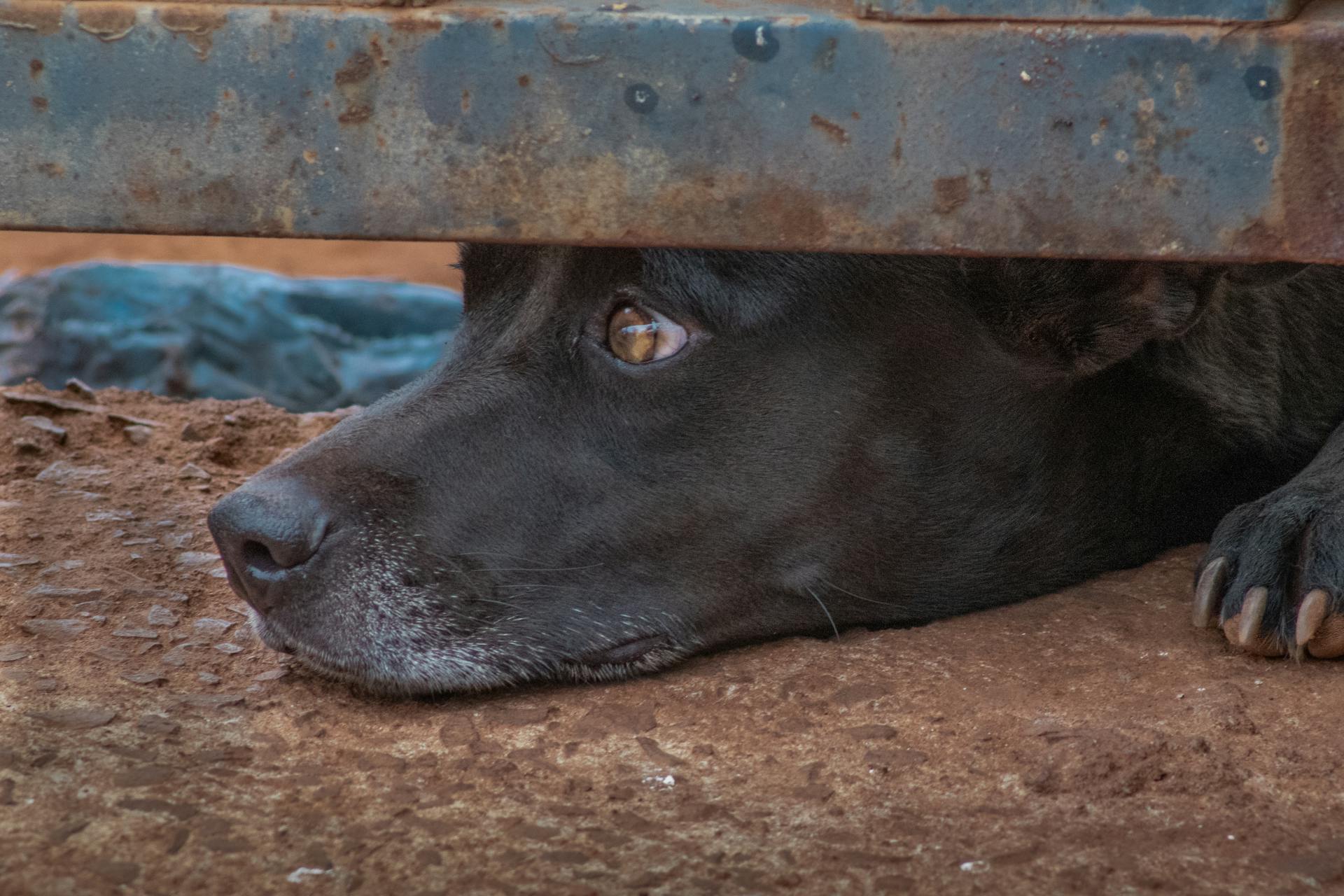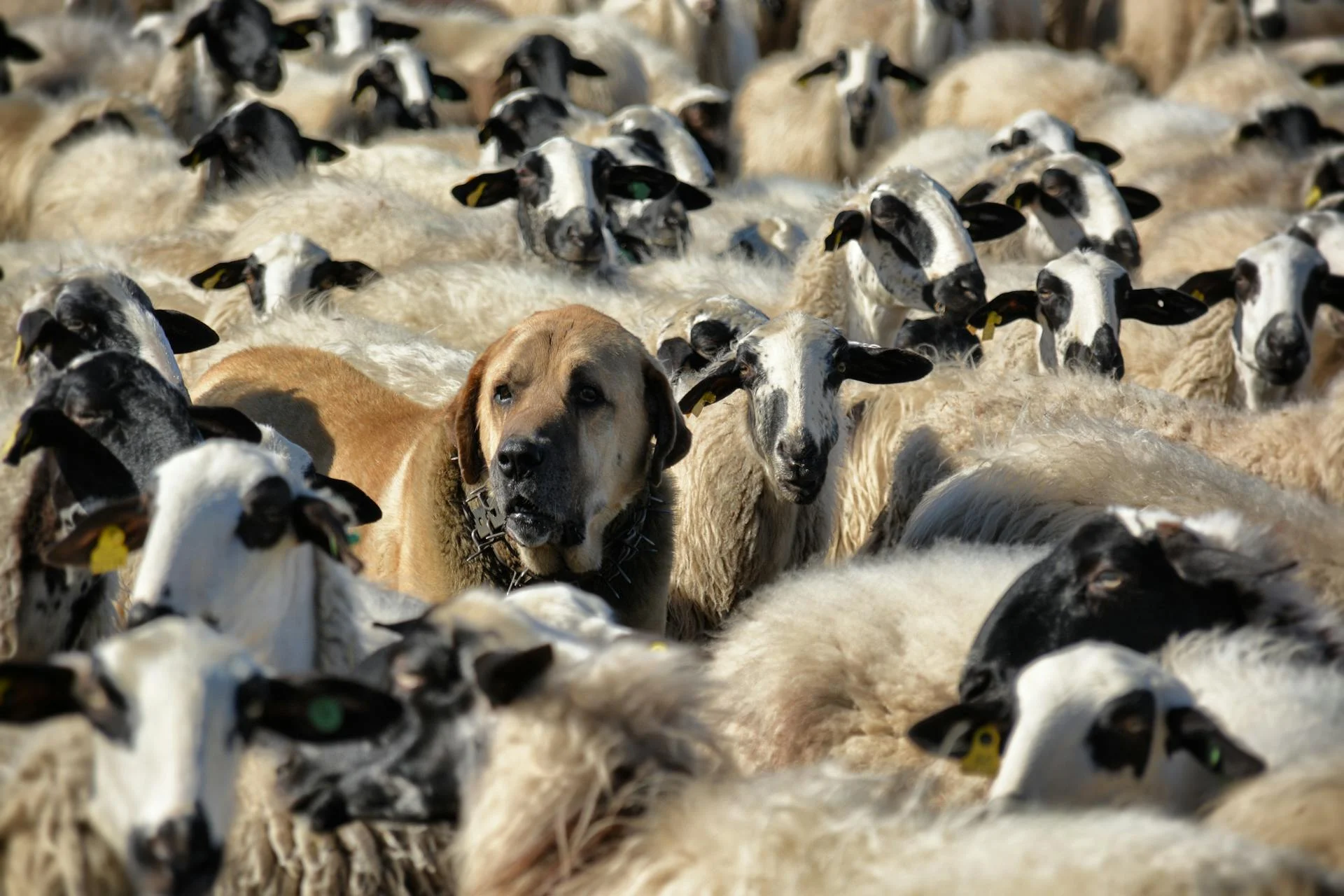
Understanding your dog's body language is crucial to building a strong bond and preventing potential conflicts. A dog's posture can convey a lot of information, such as a relaxed dog with a loose, open posture.
Dogs that are feeling anxious or fearful may display a tense posture, with their ears back and tail tucked in. This can be a sign that your dog needs some space or reassurance.
A wagging tail can be a clear indication of excitement or friendliness, but it's also worth noting that some dogs may wag their tails while feeling anxious or fearful.
By paying attention to these subtle cues, you can better understand your dog's emotional state and respond accordingly.
On a similar theme: Boarding an Anxious Dog
Dog Body Language
Dog body language is a complex form of communication that can be easily misinterpreted. A wagging tail, for example, doesn't always mean a happy dog - it could be a sign of emotional arousal, which could be excitement, frustration, or even fear.
To accurately read a dog's body language, look at the speed and direction of the wag, as well as the position of the tail. A faster wag often indicates a higher level of arousal, and the direction of the wag can also provide clues. Dogs tend to wag their tails more to the right when feeling positive, and to the left when feeling negative.
A relaxed dog, on the other hand, will have a loose, waggy posture, with ears held in their natural position, eyes that are soft and the forehead is neutral, a mouth that's either closed without tension or open in a relaxed pant, and a tail that's wagging in a wide, sweeping motion.
Here are some key signs of a relaxed dog:
- Ears: Held in their natural position
- Eyes: Soft, with a neutral forehead
- Mouth: Either closed without tension or open in a relaxed pant
- Tail: Wagging in a wide, sweeping motion
Pay attention to the tension in the tail, as well, to get a better sense of how your dog is feeling. A very loose tail and a moving hind end can indicate a happy and cheerful dog, while a stiffly wagging tail may be a sign that your dog is preparing for a negative interaction.
Discover more: Tail Chasing
Neutral Position
Observing a dog's neutral position is key to understanding their emotional state. This position can vary depending on the breed, but generally, a neutral tail is one that's not tucked between the legs or held high like a flag.
Some breeds, like the Chow Chow, naturally curl their tails over their backs, while others, like the Italian Greyhound, have a very low neutral tail position. It's essential to get to know your dog's unique neutral position to quickly recognize when their emotions shift.
A neutral tail position can be a sign of relaxation, but it's not a guarantee. To be sure, look for other body language cues, such as a soft, open mouth and relaxed ears. These signs can indicate that your dog is feeling calm and content.
If you notice your dog's tail suddenly changing position, it may be a sign of a shift in their emotional state. This is especially true if their tail was previously in a neutral position. Pay attention to the speed and direction of the wag, as well as the overall body posture, to better understand what your dog is feeling.
Readers also liked: Chow Dog Breed Aggression
Here's a quick reference guide to help you identify a neutral tail position in your dog:
- Chow Chow: Tail curls over the back
- Italian Greyhound: Tail is low and relaxed
- Other breeds: Tail is in a neutral position, not tucked or held high
By paying attention to your dog's neutral position and other body language cues, you can build a stronger bond with your furry friend and better understand their emotional state.
Tail Held Low
A tucked tail can be a clear sign that your dog is feeling anxious or scared. If your dog tucks their tail down low to the ground or between their legs, it's often a sign that they're worried or scared.
For instance, dogs who dislike the noise of a vacuum cleaner may tuck their tail whenever it comes out of the closet. This reaction shows that the noise is causing them distress.
If you notice your dog's tail held low, it's essential to address the underlying cause of their anxiety. By understanding their body language, you can take steps to help them feel more comfortable and secure.
Tail Positions
A dog's tail can tell you a lot about their mood and intentions. If your dog tucks their tail down low to the ground or between their legs, it often indicates they're worried or scared.
A dog with a tail standing straight up is probably feeling alert, excited, or focused. However, if their tail is very stiff, it could also mean the dog is preparing to fight.
Here are some key tail positions to look out for:
If you notice your dog's tail is extended from their body, even with the spine and possibly wagging slightly, it's a sign they're alert and assessing their surroundings.
Ear Positions
Ear positions can be a bit tricky to interpret, but understanding the context is key. A dog with ears pulled back may seem nervous, but it's not always the case.
A loose posture with ears slightly back can indicate curiosity, so keep an eye on their body language. On the other hand, a tense posture with ears pinned straight back is a sign of extreme fear, and it's best to remove the source of their distress.
If you notice a dog's ears are pulled back, take a closer look at their overall demeanor to get a better sense of how they're feeling.
5 Ears Forward
A dog with their ears positioned forward is probably feeling alert and focused. Their ears are up and perked, giving them a keen sense of awareness.
For some breeds, ears forward can be a normal resting pose for a particular dog, so it's essential to consider the individual dog's personality and breed characteristics.
A dog with their ears forward is often ready to take on the day, whether that's a walk, a playtime, or simply observing their surroundings.
Six Ears Back
A dog with ears pulled back might be nervous or scared, but it's not always that simple. The context is key.
If a dog has a loose posture with ears pulled slightly back, they might be curious or interested in their surroundings. This is a subtle cue to pay attention to.
A dog with a tense posture and ears pinned straight back is probably feeling extremely scared. You may want to remove whatever is frightening them at the moment, if possible.
Observing a dog's ear position can be a valuable tool in understanding their emotional state.
Eye Positions
Soft eyes indicate a calm or happy state, with relaxed lids that might make the dog look like they're squinting.
You can see soft eyes when your dog is feeling relaxed, and it's a good sign that they're comfortable in their environment.
Hard eyes, on the other hand, are a sign of a negative state of mind, and they can be a precursor to aggression.
A hard stare, where the dog looks intently at something for a long time, usually signals a threat.
Dogs often look away to calm a situation, and this can be misinterpreted as ignoring or being stubborn.
The whites of the eyes, or "whale eye", can be a sign of anxiety or stress in a situation.
Big pupils or white in the eyes are signs of fear, and your dog is likely feeling scared or anxious.
A hard stare often involves a tense and stiff face, with more of the whites of the eyes visible.
If a dog looks at you with a hard stare, it's best not to stare back, as they may perceive it as a threat and react accordingly.
Intriguing read: When Do Dachshunds Calm down
Head Positions
A dog with their head down or lowered is likely feeling uncomfortable. This can be a subtle sign, and your dog may just turn their head to the side a bit.
Lowering their head can be what's known as appeasement behavior, where the dog tries to avoid conflict by indicating they don't want to appear aggressive.
Behavioral Signs
Dogs exhibit various behavioral signs that can indicate their mood, needs, and intentions. Some of these signs include yawning, which can be a sign of stress or anxiety, as well as avoiding eye contact, which can suggest fear or submission.
A dog that's feeling anxious or stressed may also exhibit panting, pacing, or restlessness. In contrast, a relaxed dog is more likely to display calm, open-mouthed breathing and a loose, relaxed posture.
Some dogs may also exhibit behavioral signs such as raised hackles, which can indicate excitement, fear, or aggression.
Explore further: Dog Training for Fear Aggression
Appeasement
Appeasement is a common behavioral sign in dogs that can be confusing to understand. They often try to appear small and less threatening.
A dog displaying appeasement body language might lower their body to the ground or even flip over on their back to expose their stomach. This is a way for them to show deference.
Some common signs of appeasement include pinned back ears, avoiding eye contact and squinting their eyes. These behaviors can be subtle, but are often a sign of underlying anxiety or fear.
A dog's mouth can also display tension around the mouth, and they might pull back their lips to expose their front teeth in an "appeasement grin." This can look like a smile, but is actually a way of showing deference.
Their tail might be tucked or held low and moving in a slow, tight wag. This is a sign that they're trying to appear less threatening.
Here are some common signs of appeasement:
- Pinned back ears
- Avoiding eye contact and squinting their eyes
- Tension around the mouth
- Appeasement grin (exposing front teeth)
- Tucked or held low tail, moving in a slow, tight wag
Paw Lifting
Paw lifting is a common behavior in dogs that can have different meanings depending on the context. A lifted paw often means a dog is anticipating something.
Some dogs lift their paw in anticipation of receiving a treat, which is a clear indication of excitement and eagerness. Others may lift a paw in preparation to defend themselves against a perceived threat, showing a more cautious side.
It's essential to know how your pup usually behaves to understand the context of their paw lifting. This will help you determine whether they're looking forward to a reward or preparing for a potential threat.
Snapping
Snapping is a warning sign that a dog is telling you to back off and give them space. If a dog "air snaps" near you, they are giving you a serious signal: back off before they need to escalate.
Dogs usually won't miss their target if they want to bite, so if a dog is air snapping, it's likely a precursor to a real bite. This behavior is a natural warning sign that you should respect.
A unique perspective: Off the Leash Dog Training
To teach a puppy not to bite, you can use the "ouch" method, where you say "ouch" loudly and immediately leave the room for 1-2 minutes when they bite. This mimics the reaction other puppies would give to a puppy that is biting too hard.
By repeating this process, your pup should eventually learn to bite softly. Multiple people should practice this with your puppy, excluding children, to help them learn this important skill.
Some puppies may get excited by responding to their biting, causing them to bite harder. For these puppies, do not say anything and leave the room for 1-2 minutes.
Consider reading: 2 Week Dog Training
Rolling
Rolling onto their back can be a dog's way of inviting belly rubs, but it's also possible they're feeling worried and need space. A loose and relaxed posture suggests they're excited to play, while a tense or stiff body indicates discomfort.
Some dogs are more likely to roll onto their back in certain situations, such as when they're feeling relaxed and comfortable with their surroundings.
Frequently Asked Questions
What are abnormal behavior patterns in dogs?
Abnormal behavior patterns in dogs can include aggression, fear reactions, and repetitive behaviors, often linked to pain or stress. If you suspect your dog is exhibiting abnormal behaviors, learn more about the common signs and potential causes.
What are normal behaviour patterns for dogs?
Normal behaviour patterns for dogs include being playful, sociable, and enjoying interaction with toys, people, and other dogs. However, individual characteristics can vary depending on age, breed, and past experiences.
Sources
- https://www.akc.org/expert-advice/advice/how-to-read-dog-body-language/
- https://www.petmd.com/dog/behavior/how-to-read-dog-body-language
- https://be.chewy.com/decoding-dogs-body-language/
- https://reginahumanesociety.ca/programs-services/municipal-services/alternatives-to-admission/dog-behaviour-tips/puppy-developmental-stages-and-behaviour/
- https://en.wikipedia.org/wiki/Dog_behavior
Featured Images: pexels.com

